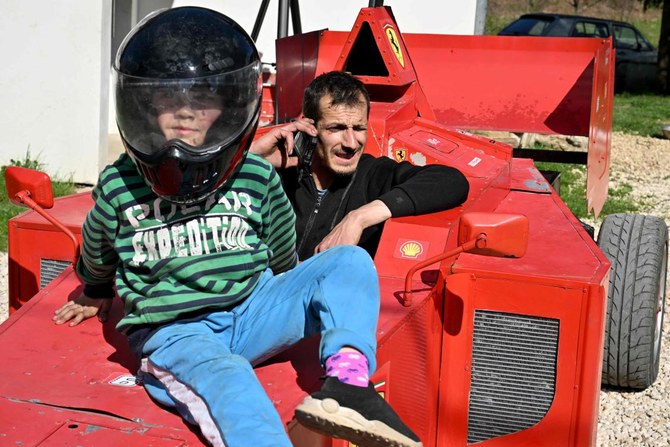WASHINGTON: Michelle Obama says she felt alone after a miscarriage 20 years ago and she and Barack Obama underwent fertility treatments to conceive their two daughters, according to her upcoming memoir.
In some of her most extensive public comments on her White House years, the former first lady also lets her fury fly over President Donald Trump’s “bigotry and xenophobia” — dangerous, deliberate rhetoric, she wrote, that risked her family’s safety.
“For this,” she writes, “I’d never forgive him.”
But it’s her deeply personal account of her marriage to the future president that shed new light on the Ivy League-educated couple’s early struggle with issues of family, ambition and public life.
“We were trying to get pregnant and it wasn’t going well,” Mrs. Obama, 54, writes in “Becoming,” set for release Tuesday. The Associated Press purchased an early copy. “We had one pregnancy test come back positive, which caused us both to forget every worry and swoon with joy, but a couple of weeks later I had a miscarriage, which left me physically uncomfortable and cratered any optimism we felt.”
The Obamas opted for IVF, one form of assisted reproduction that typically involves removing eggs from a woman, fertilizing them with sperm in a lab, and implanting the resulting embryo. It costs thousands of dollars for every “cycle,” and many couples require more than one attempt.
Mrs. Obama writes of being alone to administer herself shots to help hasten the process. Her “sweet, attentive husband” was at the state legislature, “leaving me largely on my own to manipulate my reproductive system into peak efficiency,” she said.
“Becoming” is one of the most anticipated political books in memory, ranking at the top of Amazon’s best-sellers on Friday. That’s often the case with the memoirs of former first ladies, including Hillary Clinton and Laura Bush. But Mrs. Obama defied her exalted status in the annals of history by cultivating an image of a modern woman with whom many Americans would like to sip wine and chat.
But until now, she’s not extensively shared so many details. Some family struggles, such as losing a baby, are known by millions of women.
“I felt like I failed because I didn’t know how common miscarriages were because we don’t talk about them,” the former first lady said in an interview broadcast Friday on ABC’s “Good Morning America.” “We sit in our own pain, thinking that somehow we’re broken.”
Mrs. Obama, said they underwent fertilization treatments to conceive daughters Sasha and Malia, now 17 and 20.
She also writes about falling in love. The Obamas met at the Chicago law firm Sidley Austin LLP, and Michelle was skeptical at first. But she was then impressed by his “rich, even sexy baritone” and by his “strange, stirring combination” of serenity and power.
Their first kiss set off a “toppling blast of lust, gratitude, fulfillment, wonder,” she wrote.
Confronting racism in public life — being the first black first lady, wife of the nation’s first black president — has been a bracing experience, in Mrs. Obama’s telling. She agonized over what she feared was a cartoonish, racist image. She remembered being labeled “angry” and, by the Fox network, “Obama’s Baby Mama.”
In the White House, she knew she would be labeled “other” and would have to earn the aura of “grace” given freely to her white predecessors. She found confidence in repeating to herself a favorite chant: “Am I good enough? Yes I am.”
In the memoir, Mrs. Obama lets loose a blast of anger at Trump.
She writes that Trump’s questioning of whether her husband was an American citizen was “crazy and mean-spirited” — and “dangerous.” Trump suggested Obama was not born in the US but on foreign soil — his father was Kenyan. The former president was born in Hawaii.
“What if someone with an unstable mind loaded a gun and drove to Washington? What if that person went looking for our girls?” she writes in the memoir. “Donald Trump, with his loud and reckless innuendos, was putting my family’s safety at risk. And for this, I’d never forgive him.”
As he left for Paris Friday, Trump chose not to respond to the former first lady, telling reporters, “Oh, I guess she wrote a book. She got paid a lot of money to write a book and they always insisted you come up with controversial.” Trump instead changed the subject to his predecessor, Barack Obama, saying, “I’ll never forgive him” for making the country “very unsafe.”
Mrs. Obama also expresses disbelief over how so many women would choose a “misogynist” over Clinton in 2016. She remembers how her body “buzzed with fury” after seeing the infamous “Access Hollywood” tape, in which Trump brags about sexually assaulting women.
She also accuses Trump of using body language to “stalk” Clinton during an election debate. She writes of Trump following Clinton around the stage, standing nearby and “trying to diminish her presence.”
Mrs. Obama launches her promotional tour Tuesday not at a bookstore, but at Chicago’s United Center, where tens of thousands of people have purchased tickets — from just under $30 to thousands of dollars — to attend the event moderated by Oprah Winfrey.
Michelle Obama had miscarriage, used IVF to conceive girls
Michelle Obama had miscarriage, used IVF to conceive girls

- She writes that Trump’s questioning of whether her husband was an American citizen was “crazy and mean-spirited” — and “dangerous”
- Confronting racism in public life — being the first black first lady, wife of the nation’s first black president — has been a bracing experience, in Mrs. Obama’s telling
Used missiles for sale: Iranian weapons used against Israel are up for grabs on Jordan-based website
Used missiles for sale: Iranian weapons used against Israel are up for grabs on Jordan-based website

- Debris used in attack listed on OpenSooq online marketplace
LONDON: Fragments of missiles launched by Iran during the recent attack on Israel have been discovered for sale on Jordan’s prominent OpenSooq website, which is known for trading goods, including vehicles and real estate.
Al Arabiya reported on Sunday that the shrapnel was being advertised, with pieces described as “Used Iranian ballistic missile in good condition for sale,” and “One-time use ballistic missile for sale at an attractive price.”
The sellers had provided specifications and images of the missiles, describing them as “excellent type,” and mentioned their involvement in an “accident” resulting in “severe damage to the body.”
Some listings even included installment payment options.
Iran launched drones and missiles toward Israel late on Saturday as it retaliated following a suspected Israeli strike on the consulate annex building adjacent to the Iranian Embassy in Damascus, Syria, earlier this month.
While most projectiles were intercepted by a joint response from Israel, the US, UK, France, and Jordan, the attack marked Iran’s first direct military assault on Israeli territory, escalating tension and uncertainty in the region.
Following the attack, individuals shared photographs online showing debris that had fallen on Jordanian territory in areas such as Al-Hasa, Marj Al-Hamam, and Karak Governorate.
The Jordanian government confirmed that it had intercepted some flying objects in its airspace, with no reported damage or injuries.
Debris from such incidents often holds economic value. Metal debris from the Iraq War has been used by Iran-backed groups to finance their activities.
Similar items are sold online as military memorabilia, and there has been a surge in demand for such artifacts, as seen in Australia last year, preceding the country’s ban on the sale of hate symbols.
Google Doodle celebrates Lebanese-American poet and artist Etel Adnan

- Etel Adnan rose to fame for her 1977 novel Sitt Marie Rose about the Lebanese civil war
DUBAI: Google released its latest Doodle on Monday honoring Etel Adnan, a Lebanese-American poet, essayist and visual artist, considered one of the most accomplished Arab-American authors of her era.
The poet, who rose to fame for her 1977 novel Sitt Marie Rose about the Lebanese civil war, was born in Lebanon in 1925 to a Greek mother and a Syrian father, and grew up in multiple cultures, languages, nationalities and religions. Sitt Marie Rose won the France-Pays Arabes award and become a classic of war literature, so much so that it is taught in American classrooms.
In 1949, Adnan went to Paris to study philosophy at the Sorbonne before going to America to study at Harvard and Berkeley.
From 1958 to 1972, she taught philosophy in California, during which time she also started painting and writing poetry. She developed her literary voice in English and said abstract painting was the entry point into her native Arabic.
Adnan returned to Beirut, where from 1972 to 1976 she worked as the arts editor for two newspapers. She returned to California in 1979, then spent her later years living between Paris and Beirut.
In 2003, Adnan was named “arguably the most celebrated and accomplished Arab American author writing today” by the academic journal MELUS: Multi-Ethnic Literature of the United States.
Adnan’s most recent honor was in 2020. Her poetry collection “Time,” which is a selection of her work — translated from French by Sarah Riggs — won the Griffin Poetry Prize.
The King Abdulaziz Center for World Culture, or Ithra, earlier this year opened an eponymous exhibition in her honor – “Etel Adnan: Between East and West” – showcasing 41 of her works. The space at Ithra’s gallery is the first solo exhibition of Adnan’s work in Saudi Arabia, running until June 30.
The works on display span from the beginning of Adnan’s artistic career in the late 1950s through to her final creations in 2021, shortly before her death that year aged 96.
Some of the works are on loan from significant international institutions such as the Sharjah Art Foundation, Sfier-Semler Gallery and Sursock Museum. Some are part of private collections.
‘HELP’ written in palm fronds lands rescue for Pacific castaways

- The trio became stranded on Pikelot Atoll, a tiny island in the remote Western Pacific, after their motor-powered skiff malfunctioned
- A US Navy aircraft saw the "help" sign and a ship came later to rescue the stranded trio, all experienced mariners in their 40s
LOS ANGELES: Sometimes all you have to do is ask for “HELP“: That’s what three men stranded on a deserted Pacific island learned earlier this week, writing the message in palm fronds which were spotted by US rescuers.
The trio, all experienced mariners in their 40s, became stranded on a lonely island after setting off from Micronesia’s Polowat Atoll on March 31 in their motor-powered skiff which subsequently experienced damage.
They were reported missing last Saturday by a woman who told the US Coast Guard her three uncles never returned from Pikelot Atoll, a tiny island in the remote Western Pacific.
“In a remarkable testament to their will to be found, the mariners spelled out ‘HELP’ on the beach using palm leaves, a crucial factor in their discovery,” said search and rescue mission coordinator Lt. Chelsea Garcia.
She reported that the trio was discovered Sunday on Pikelot Atoll by a US Navy aircraft.
“This act of ingenuity was pivotal in guiding rescue efforts directly to their location,” she said.
The aircraft crew dropped survival packages, and rescuers one day later dropped a radio which the mariners used to communicate that they were in good health, had access to food and water, and that the motor on their 20-foot (six-meter) skiff was no longer working.
On Tuesday morning a ship rescued the trio and their equipment, returning them to Polowat Atoll, the Coast Guard said.
In August 2020, three Micronesian sailors also stranded on Pikelot were rescued after Australian and US warplanes spotted a giant “SOS” they had scrawled on the beach.
Dining hall with Trojan War decorations uncovered in ancient Roman city of Pompeii

- One fresco depicts Paris and Helen, whose love affair caused the Trojan War, according to classical accounts
- Pompeii and the surrounding countryside was submerged by volcanic ash when Mount Vesuvius exploded in AD 79
ROME: A black-walled dining hall with 2,000-year-old paintings inspired by the Trojan War has been discovered during excavations at the Roman city of Pompeii, authorities said on Thursday.
The size of the room — about 15 meters long and 6 meters wide — the quality of the frescoes and mosaics from the time of Emperor Augustus, and the choice of characters suggest it was used for banquets, Pompeii Archaeological Park said.

“The walls were painted black to prevent the smoke from the oil lamps being seen on the walls,” Gabriel Zuchtriegel, head of the park, said.
“People would meet to dine after sunset, and the flickering light of the lamps had the effect of making the images appear animated, especially after a few glasses of good Campanian wine.”
Pompeii and the surrounding countryside was submerged by volcanic ash when Mount Vesuvius exploded in AD 79, killing thousands of Romans who had no idea they were living beneath one of Europe’s biggest volcanoes.
The site has seen a burst of archaeological activity aimed at halting years of decay and neglect, largely thanks to a 105-million-euro ($112 million) European Union-funded project.

The dominant theme of the newly discovered paintings is heroism and fate.
One fresco depicts Paris and Helen, whose love affair caused the Trojan War, according to classical accounts. Another one shows doomed prophetess Cassandra and the Greco-Roman god Apollo.
According to Greek mythology, Cassandra predicted the Trojan War after receiving the gift of foresight from Apollo, but no-one believed her. This was because of a curse Apollo put upon her for refusing to give herself to him.
Bosnian Formula One fan brings speed dreams to the mountains

- The 36-year-old mechanic bought the car from another racing superfan in the capital Sarajevo last year
- Since purchasing the vehicle, he has been methodically making tweaks to its exterior, while nursing hopes of one day replacing its engine
KLJUC, Bosnia and Herzegovina: Far from the glitzy racetracks where legendary drivers made their mark in the world of Formula One, Himzo Beganovic has turned his dreams of speed into reality along the dirt roads of northwestern Bosnia.
“I always wanted to own a Formula One car, to have it in front of the house, to be able to go for a spin,” Beganovic told AFP, as he tuned up a replica “Ferrari red” race car outside his home near the Bosnian town of Kljuc.
The 36-year-old mechanic bought the car from another racing superfan in the capital Sarajevo last year.
The replica, which took two years to build, remains a ramshackle mock-up, crafted with sheet metal — a far cry from the advanced carbon fiber used in the multimillion-dollar cars of Formula One teams.
Despite Beganovic’s limited means, he still hopes to make his car more efficient, bit by bit.
Since purchasing the vehicle, he has been methodically making tweaks to its exterior, while nursing hopes of one day replacing its engine.
Along with a more powerful motor, Beganovic hopes to install an automatic gearbox and better tires.
“When you drive Formula One, you feel like you are flying. It is not like a car,” he said.
“It is the only one in Bosnia-Herzegovina. There are no others.”
A self-professed lover of “fast driving” and taking “dangerous turns,” Beganovic has been turning heads along Bosnia’s mountain roads where he reaches speeds of up to 200 kilometers per hour (124 miles per hour).
Other times he simply parks the car in a popular area and lets people check it out.
“I sometimes put it on a trailer to take it to other places in the country. People come, photograph it, and ask questions,” he said.
“The feeling is indescribable.”
For Beganovic, there was no question of what color the car would be.
As a longtime fan of seven-time world champion Michael Schumacher, the Ferrari-red paint pays tribute to the driver who won five titles with the famous Italian team.
Since the legendary German champion’s skiing accident in 2013 in the French Alps, Beganovic said he has yet to find another driver that interests him as much.
With Schumacher in mind, he hopes to put an Audi V-8 engine into his car soon.
“When a German engine and Bosnian ingenuity combine, you get an Italian car,” laughed one of Beganovic’s neighbors.



















